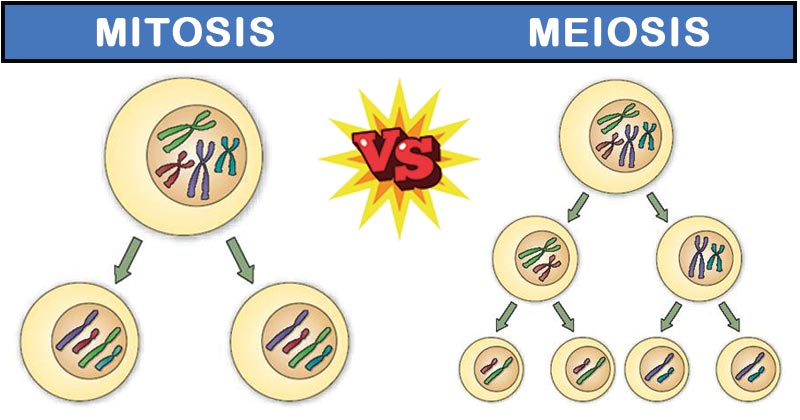Did you know that we lose around 50 million skin cells every single day? If there weren’t for cell division, we wouldn’t be able to survive. Furthermore, we wouldn’t even exist if our parents’ cells could not reproduce. This right there is mitosis and meiosis.
You’re still a bit confused? Well, let’s start from the basics.
What is mitosis?
According to the National Human Genome Research Institute (NHGRI), mitosis is “the process by which a cell replicates its chromosomes and then segregates them, producing two identical nuclei in preparation for cell division. Mitosis is generally followed by equal division of the cell’s content into two daughter cells that have identical genomes”.
Now, these are two pretty long sentences, so let’s break them down a little bit.
Mitosis is a process by which:
- a cell replicates its chromosomes and then segregates them
- this results in producing two identical nuclei in preparation for cell division
- that’s generally followed by equal division of the cell’s content into two daughter cells
- these daughter cells have identical genomes.
Before we compare mitosis to meiosis, we’re also going to start by looking at the definition of meiosis.
What is meiosis?
According to the NHGRI, meiosis is “Meiosis is a type of cell division in sexually reproducing organisms that reduces the number of chromosomes in gametes (the sex cells, or egg and sperm). In humans, body (or somatic) cells are diploid, containing two sets of chromosomes (one from each parent). During meiosis, each diploid cell undergoes two rounds of division to yield four haploid daughter cells — the gametes”.
We’re going to simplify this a bit. So, meiosis is a type of cell division:
- happens in sexually reproducing organisms
- it reduces the number of chromosomes in the sex cells
- there are two rounds of cell division
- this division results in four haploid daughter cells.
Now let’s go over the similarities and differences between mitosis and meiosis.
Key similarities
In general, mitosis and meiosis are similar. They are both processes that result in cell division. They have the same stages and what happens during those stages is somewhat similar.
But, there are also some major differences we should go over.
Key differences
There are three differences you should keep in mind:
-
They have different purposes.
If you go back to the definition of meiosis, you’ll notice that we mentioned sex cells. That’s because meiosis is used for the reproduction of sex cells only. Because of meiosis, we can create a new life, a unique human being.
Mitosis, on the other hand, is present in other body cells. A living organism can grow and repair cells using mitosis. Mitosis makes our hair and nails grow, it heals our wounds, torn tissues, and muscles. Organisms that can’t reproduce sexually use mitosis to reproduce asexually.
-
Their division cycle is different.
The mitosis cycle has five stages: prophase, prometaphase, metaphase, anaphase, and telophase.
Before these stages occur, your cells spend time in interphase. This is when the parent cell copies its DNA material so that two cells that come out of mitosis (daughter cells) are identical to the parent cell.
Once the genetic material is copied, prophase begins. In this stage, the cell’s chromosomes become denser and form X-like structures. The nucleus disappears and the mitotic spindle, which is responsible for separating the chromosomes between daughter cells, forms.
During the prometaphase, chromosomes continue to dense up, and the nuclear membrane breaks down. Microtubules (a part of the mitotic spindle) latch onto the chromosomes and start moving them around.
Once metaphase occurs, chromosomes concentrate in the middle of the parent cells, which is followed by anaphase. This is when microtubules start pulling the chromosomes apart, trying to split them into two.
At last, in telophase two new sets of chromosomes start to decondense at the opposite sides, the new nuclear membrane forms around each set of chromosomes, and the nucleus forms again.
The meiosis cycle is a bit more complicated. It’s comprised of two rounds – meiosis I and meiosis II.
Meiosis I has the same stages as mitosis with a big difference in the prophase I stage.
During prophase I, chromosomes condense and pair up, forming homologous pairs. This stage can last anywhere from 5 hours in yeast to over 40 years in human females. That’s also when crossing over occurs – two chromosomes, one from the mother and one from the father, line up and switch part of the chromosome.
Once this stage is over, prometaphase I, metaphase I, anaphase I, and telophase I occur.
Because chromosomes exchanged their genetic materials, we now have two different haploid daughter cells and the end of meiosis I. They then enter the stage of meiosis II which also has five stages that are completely the same as those in mitosis.
-
The number of produced daughter cells is different.
Because mitosis has only one round of cell division, we have two identical daughter cells at the end.
Meiosis has two rounds: meiosis I and meiosis II. During prophase I, chromosomes exchange genetic material. As a result, we have four daughter cells with different genetic materials.
The genetic composition of daughter cells is different.
To sum up
Cell division can occur in two ways: mitosis and meiosis.
Mitosis occurs in body cells for the purpose of repairing and growing, while meiosis includes only sex cells and happens during sexual reproduction. Both mitosis and meiosis have five stages, but meiosis has two rounds of these stages.
Because of that, mitosis results in two daughter cells while meiosis results in four daughter cells. The daughter cells involved in mitosis are the same as parent cells, while the daughter cells in meiosis are not identical because they exchange genetic material.







